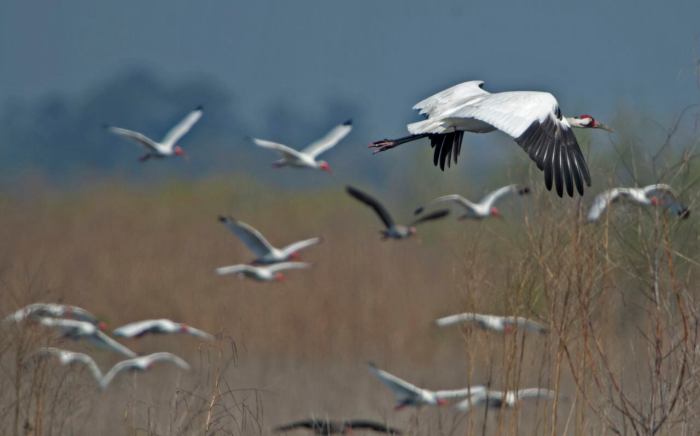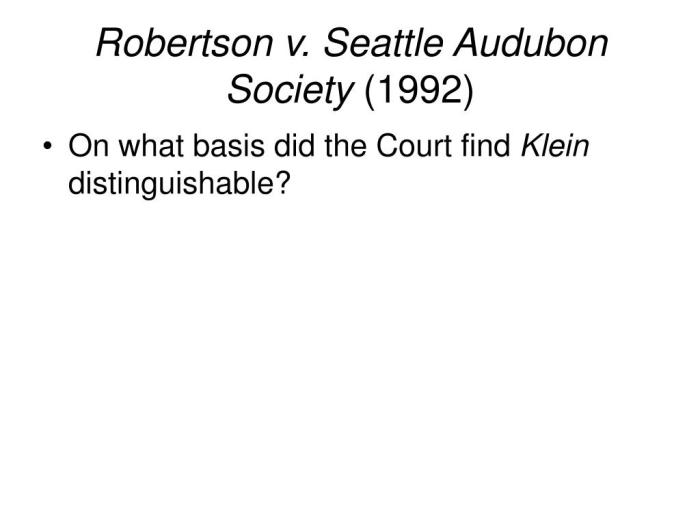Robertson v. Seattle Audubon Society is a pivotal case in the annals of environmental law, shaping the legal landscape and influencing environmental regulation in the United States. This case exemplifies the complex interplay between environmental protection and property rights, leaving a lasting legacy on the interpretation of environmental statutes.
The case revolves around the conflict between the Seattle Audubon Society’s bird sanctuary and Robertson’s desire to develop his adjacent property. Robertson argued that the sanctuary’s presence constituted a taking of his property without just compensation, while the Audubon Society asserted its right to protect the habitat.
The legal battle that ensued tested the limits of environmental regulation and set precedents that continue to guide environmental decision-making today.
Overview of Robertson v. Seattle Audubon Society

Robertson v. Seattle Audubon Society(1992) is a landmark environmental law case that addresses the issue of whether the Endangered Species Act (ESA) preempts local land use regulations that protect endangered species.
The case arose when the Seattle Audubon Society sued the city of Seattle for violating the ESA by allowing the construction of a housing development that would harm the habitat of the northern spotted owl, an endangered species. The city argued that its land use regulations, which were designed to protect the owl, were not preempted by the ESA.
The Supreme Court ruled in favor of the Seattle Audubon Society, holding that the ESA preempts local land use regulations that conflict with the ESA’s goal of protecting endangered species. The Court found that the ESA’s broad language and legislative history demonstrate that Congress intended to create a comprehensive scheme for the protection of endangered species, and that local land use regulations that conflict with that scheme are preempted.
The Robertsondecision has had a significant impact on environmental law. It has clarified the scope of the ESA’s preemption provision and has made it more difficult for local governments to adopt land use regulations that protect endangered species.
Legal Arguments and Precedents
The Seattle Audubon Society argued that the ESA preempts the city’s land use regulations because the ESA is a comprehensive scheme for the protection of endangered species and the city’s regulations conflict with that scheme. The city argued that its land use regulations are not preempted because they are not inconsistent with the ESA and they are necessary to protect the northern spotted owl.
The Supreme Court agreed with the Seattle Audubon Society, finding that the ESA’s broad language and legislative history demonstrate that Congress intended to create a comprehensive scheme for the protection of endangered species, and that local land use regulations that conflict with that scheme are preempted.
The Court relied on several precedents in reaching its decision. In Gibbons v. Ogden(1824), the Court held that the Commerce Clause gives Congress the power to regulate activities that substantially affect interstate commerce. In McCulloch v. Maryland(1819), the Court held that the Necessary and Proper Clause gives Congress the power to enact laws that are necessary to carry out its enumerated powers.
The Court found that the ESA is a valid exercise of Congress’s power under the Commerce Clause and the Necessary and Proper Clause. The Court also found that the ESA’s preemption provision is constitutional because it is necessary to achieve the ESA’s goal of protecting endangered species.
Impact on Environmental Regulation, Robertson v. seattle audubon society
The Robertsondecision has had a significant impact on environmental regulation. It has clarified the scope of the ESA’s preemption provision and has made it more difficult for local governments to adopt land use regulations that protect endangered species.
The decision has also led to increased litigation over the ESA’s preemption provision. In the years since Robertsonwas decided, there have been numerous cases in which local governments have challenged the ESA’s preemption provision. In some cases, the courts have upheld the ESA’s preemption provision, while in other cases the courts have found that the ESA does not preempt local land use regulations.
The Robertsondecision has also had a significant impact on the development of environmental policy. In the wake of Robertson, Congress has amended the ESA several times to address the issue of preemption. In 1995, Congress passed the Private Property Protection Act, which limits the ESA’s preemption provision in certain circumstances.
In 2000, Congress passed the Transportation Equity Act for the 21st Century, which exempts certain transportation projects from the ESA’s preemption provision.
FAQ Guide: Robertson V. Seattle Audubon Society
What was the central issue in Robertson v. Seattle Audubon Society?
The central issue was whether the presence of the Seattle Audubon Society’s bird sanctuary constituted a taking of Robertson’s property without just compensation.
What legal arguments did Robertson present?
Robertson argued that the sanctuary’s presence interfered with his right to develop his property and diminished its value, thus constituting a taking under the Fifth Amendment.
What legal arguments did the Seattle Audubon Society present?
The Audubon Society argued that the sanctuary was a legitimate exercise of its right to protect wildlife and habitat, and that Robertson’s property rights were not violated.
What was the significance of the Supreme Court’s decision?
The Supreme Court ruled in favor of the Seattle Audubon Society, holding that the sanctuary did not constitute a taking of Robertson’s property. The Court emphasized the importance of protecting endangered species and recognized the government’s authority to regulate private property for environmental purposes.

